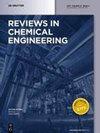Metals and metal oxides polymer frameworks as advanced anticorrosive materials: design, performance, and future direction
IF 6.6
3区 工程技术
Q1 ENGINEERING, CHEMICAL
引用次数: 0
Abstract
Abstract Metals (Ms) and metal oxides (MOs) possess a strong tendency to coordinate and combine with organic polymers to form respective metal–polymer frameworks (MPFs) and metal oxide polymer frameworks (MOPFs). MPFs and MOPFs can be regarded as composites of organic polymers. MPFs and MOPFs are widely used for industrial and biological applications including as anticorrosive materials in the aqueous phase as well as in the coating conditions. The presence of the Ms and MOs in the polymer coatings improves the corrosion inhibition potential of MPFs and MOPFs by improving their self-healing properties. The Ms and MOs fill the micropores and cracks through which corrosive species such as water, oxygen, and corrosive ions and salts can diffuse and destroy the coating structures. Therefore, the Ms and MOs enhance the durability as well as the effectiveness of the polymer coatings. The present review article is intended to describe the corrosion inhibition potential of some MPFs and MOPFs of some most frequently utilized transition metal elements such as Ti, Si, Zn, Ce, Ag, and Au. The mechanism of corrosion inhibition of MPFs and MOPFs is also described in the presence and absence of metal and metal oxides.金属和金属氧化物聚合物框架作为先进的防腐材料:设计、性能和未来方向
摘要金属(Ms)和金属氧化物(MOs)具有与有机聚合物配位结合形成金属-聚合物框架(mpf)和金属氧化物聚合物框架(mopf)的强烈倾向。MPFs和MOPFs可以看作是有机聚合物的复合材料。mpf和mopf广泛用于工业和生物应用,包括在水相和涂层条件下作为防腐材料。高分子涂层中Ms和MOs的存在通过改善MPFs和MOPFs的自修复性能,提高了它们的缓蚀潜力。Ms和MOs填充了微孔和裂缝,水、氧、腐蚀性离子和盐等腐蚀性物质可以通过这些微孔和裂缝扩散并破坏涂层结构。因此,Ms和MOs提高了聚合物涂层的耐久性和有效性。本文综述了钛、硅、锌、铈、银、金等过渡金属元素的缓蚀性能。本文还讨论了金属氧化物和金属氧化物存在和不存在情况下MPFs和MOPFs的缓蚀机理。
本文章由计算机程序翻译,如有差异,请以英文原文为准。
求助全文
约1分钟内获得全文
求助全文
来源期刊

Reviews in Chemical Engineering
工程技术-工程:化工
CiteScore
12.30
自引率
0.00%
发文量
37
审稿时长
6 months
期刊介绍:
Reviews in Chemical Engineering publishes authoritative review articles on all aspects of the broad field of chemical engineering and applied chemistry. Its aim is to develop new insights and understanding and to promote interest and research activity in chemical engineering, as well as the application of new developments in these areas. The bimonthly journal publishes peer-reviewed articles by leading chemical engineers, applied scientists and mathematicians. The broad interest today in solutions through chemistry to some of the world’s most challenging problems ensures that Reviews in Chemical Engineering will play a significant role in the growth of the field as a whole.
 求助内容:
求助内容: 应助结果提醒方式:
应助结果提醒方式:


